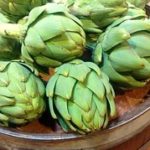Author – Katie Chriest
Whether steamed to succulent perfection or marinated in a delectable oil and herb blend, the globe artichoke adds a singular sensory experience to any meal. This bud, harvested before flowering, is related to the thistles ubiquitous the world over, and would produce a similarly lovely purple flower if left to bloom. But it wouldn’t taste nearly as good.

The globe artichoke’s Mediterranean origins make it a bit fussy climate-wise. Still, intrepid gardeners anywhere may find success in growing it, provided they can count on about 100 frost-free days. And according to Virginia Cooperative Extension, “The development of cultivars suited to annual production has opened the potential for artichokes as a seasonal vegetable crop in Northeast and Mid-Atlantic states. Locally grown artichokes have been successfully marketed in upscale, Northern Virginia farmers markets.”
Globally, Italy remains the leader in artichoke production, with numbers that vastly exceed those of the United States’ (though we still rank in the top 10). Nevertheless, in 2013, artichokes were named “California’s Official Vegetable.” According to the California Artichoke Advisory Board, “99.99 percent of all commercially grown [US] artichokes are grown in California and no other commodity can claim such exclusivity to the state.”
Such limited cultivation of artichokes in the US makes controlling pests like the artichoke plume moth all the more critical.
According to the University of California Statewide Integrated Pest Management Program (UC IPM), “Artichoke plume moth is primarily a problem where artichokes are grown as perennials, and thus is mainly a problem in California’s central coast.”
But thanks to IR-4, growers now may employ the newly-registered insecticide emamectin benzoate to control this pest, the larvae of which cause the loss of 25-50 percent of California’s artichoke crop.
“Larvae will feed on any part of the plant, but the economic damage occurs when they feed on the floral buds and render them unmarketable,” UC IPM continues. “Occasionally plants are damaged when the larvae feed in the developing plant shoots; damaged shoots, however, often recover. Larvae may also bore into the crown below the soil surface. If infested crowns are used for vegetative propagation, the pest will establish itself quickly in the newly planted field.”
The insecticide methidathion had effectively controlled artichoke plume moths, but was also toxic to birds and aquatic life, according to the Extension Toxicology Network. When its registration was canceled in 2012, artichoke growers were left without a viable alternative. Thus, they may have resorted to more broad-spectrum insecticides, leading to negative repercussions on non-target insects.
“It used to be that most of the insecticides were broad spectrum, and would knock out all of the insects that you had,” explains Ken Samoil, a research coordinator and study director in the registrations team at IR-4 headquarters. “But the trend over the last few decades has been for insecticides that target a particular order of insects, so you’re only going after those pests and you’re not killing so many other insects that are not harmful. So there’s less impact on the beneficial or neutral insects that just happen to be in the field.”
Emamectin benzoate specifically controls lepidopteran pests—or caterpillars, the larval form of moths and butterflies.
“Artichokes are a very unique crop in terms of how they’re grown. In the US, they’re grown in a small area of California and they aren’t similar to other crops, so they’ll have pests like the artichoke plume moth, which is not an insect pest of any other food commodity that I’m aware of. So when they have insecticide needs—and this may also be true for fungicides—it’s often specific to artichokes. They can’t just tag along on what’s being done on other commodities,” Samoil explains.
“All of our requests at IR-4 for the residue studies are for a particular chemical—insecticide, herbicide, fungicide—for that particular commodity, and there has to be a reason given for wanting that pesticide,” he adds. “So emamectin benzoate was requested because they needed to control the artichoke plume moth, and they were losing the previous insecticide that had been effective.”
As for biological control, UC IPM says that “Natural enemies, especially parasitic wasps, attack the artichoke plume moth. Most of the parasites attack the larvae. However, these parasites are seldom important in control because the larva spends most of its time feeding within the plant, protected from natural enemies.”
For now, with US artichoke cultivation concentrated in California, reliably defending against the artichoke plume moth remains critical to growers’ success. Time will tell if emamectin benzoate will be needed by growers exploring their options in other parts of the US.
“Often when people start growing a crop in a new area, it does not have the pests that are problem where it’s normally grown,” Samoil explains. “There can be a few years where the growers have very little need for insecticides in particular. But eventually, there could be other pests in the new area that will happen upon the artichokes and become a major pest. So something that we don’t even realize could be an artichoke pest could become one within a few years.”
He adds that “If growers decide in the East that [growing artichokes] is worthwhile, and they’re going to continue it, and then they start having pest problems that are different than those experienced in California, then they would submit requests to IR-4 for insecticides or fungicides that would take care of those pest problems.”
And fewer pests mean more delicious artichokes on our stateside plates.
Katie Chriest is a freelance technical writer in Erie, Pennsylvania; kmc503@psu.edu.
